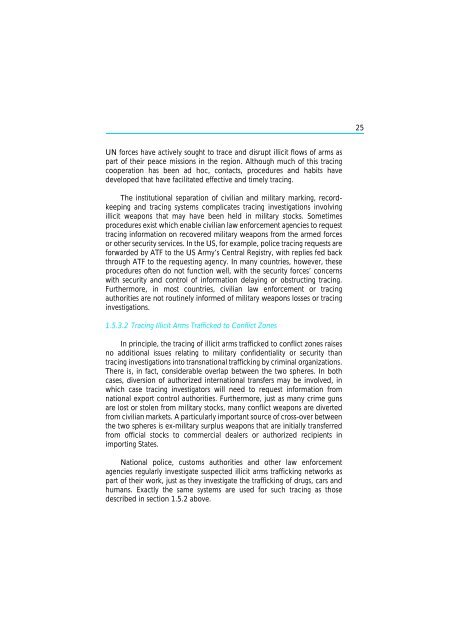The Scope and Implications of a Tracing Mechanism for Small Arms ...
The Scope and Implications of a Tracing Mechanism for Small Arms ...
The Scope and Implications of a Tracing Mechanism for Small Arms ...
Create successful ePaper yourself
Turn your PDF publications into a flip-book with our unique Google optimized e-Paper software.
25<br />
UN <strong>for</strong>ces have actively sought to trace <strong>and</strong> disrupt illicit flows <strong>of</strong> arms as<br />
part <strong>of</strong> their peace missions in the region. Although much <strong>of</strong> this tracing<br />
cooperation has been ad hoc, contacts, procedures <strong>and</strong> habits have<br />
developed that have facilitated effective <strong>and</strong> timely tracing.<br />
<strong>The</strong> institutional separation <strong>of</strong> civilian <strong>and</strong> military marking, recordkeeping<br />
<strong>and</strong> tracing systems complicates tracing investigations involving<br />
illicit weapons that may have been held in military stocks. Sometimes<br />
procedures exist which enable civilian law en<strong>for</strong>cement agencies to request<br />
tracing in<strong>for</strong>mation on recovered military weapons from the armed <strong>for</strong>ces<br />
or other security services. In the US, <strong>for</strong> example, police tracing requests are<br />
<strong>for</strong>warded by ATF to the US Army’s Central Registry, with replies fed back<br />
through ATF to the requesting agency. In many countries, however, these<br />
procedures <strong>of</strong>ten do not function well, with the security <strong>for</strong>ces’ concerns<br />
with security <strong>and</strong> control <strong>of</strong> in<strong>for</strong>mation delaying or obstructing tracing.<br />
Furthermore, in most countries, civilian law en<strong>for</strong>cement or tracing<br />
authorities are not routinely in<strong>for</strong>med <strong>of</strong> military weapons losses or tracing<br />
investigations.<br />
1.5.3.2 <strong>Tracing</strong> Illicit <strong>Arms</strong> Trafficked to Conflict Zones<br />
In principle, the tracing <strong>of</strong> illicit arms trafficked to conflict zones raises<br />
no additional issues relating to military confidentiality or security than<br />
tracing investigations into transnational trafficking by criminal organizations.<br />
<strong>The</strong>re is, in fact, considerable overlap between the two spheres. In both<br />
cases, diversion <strong>of</strong> authorized international transfers may be involved, in<br />
which case tracing investigators will need to request in<strong>for</strong>mation from<br />
national export control authorities. Furthermore, just as many crime guns<br />
are lost or stolen from military stocks, many conflict weapons are diverted<br />
from civilian markets. A particularly important source <strong>of</strong> cross-over between<br />
the two spheres is ex-military surplus weapons that are initially transferred<br />
from <strong>of</strong>ficial stocks to commercial dealers or authorized recipients in<br />
importing States.<br />
National police, customs authorities <strong>and</strong> other law en<strong>for</strong>cement<br />
agencies regularly investigate suspected illicit arms trafficking networks as<br />
part <strong>of</strong> their work, just as they investigate the trafficking <strong>of</strong> drugs, cars <strong>and</strong><br />
humans. Exactly the same systems are used <strong>for</strong> such tracing as those<br />
described in section 1.5.2 above.
















